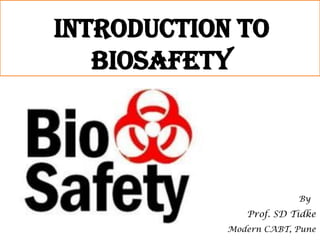
Biosafety - History, Levels and issues
- 1. Introduction to Biosafety By Prof. SD Tidke Modern CABT, Pune
- 2. Biosafety • According to the Centre Of Disease Control and Prevention (CDC) • Biosafety is the application of safety precautions that reduce a laboratorians risk of exposure to a potentially infectious material and limit contamination of the work environment and ultimately the community.” • Biosafetymeans safetyfromexposure to infectiousagents.
- 3. HistoryOfBiosafety History: • On18 april 1955 the first biological safety conferrence took place at Camp Detrick in Fredrick, Maryland in presence of fourteen representatives from three Principal Laboratories of U.SArmy. • Biosafety,chemical, radiological & industrial safety issueswerediscussed. • Later in the United States, the Centers for Disease Control (CDC)specified 4 different levels of biocontainment which ranges from Biosafety level 1 (BSL-1) to Biosafety level 4(BSL-4).
- 4. Need of biosafety Lab has hazards of processing infectious agents Accidental threat to workers and environment To have adherence with safety regulations while dealing with highly infectious agents
- 5. Scope of biosafety Biosafety Ecology Agriculture Medicine Exobiology Chemistry
- 7. Biosafety In Academic Research • Promoting safe laboratory practices, and procedures • proper use of containment equipment and facilities • provides advice on laboratory design and risk assessment of experiments involving infectious agents, rDNA in-vitro and in-vivo.
- 8. Biohazard Symbol • Charles Baldwin at National Cancer Institute at NIH. • Symbol to be “memorable but meaningless” so it could be learned.
- 9. Biohazardous Materials • Viruses • Bacteria • Fungi • Chlamydiae/Rickettsiae • Prions • Recombinant DNA
- 10. Biohazardous Materials • Transgenic Plants, Animals and Insects
- 12. Biosafety Issues • Laboratory Safety • Bloodborne pathogens (BBP) • Recombinant DNA (rDNA) • Biological waste disposal • Infectious substance and diagnostic specimen shipping
- 13. Biosafety Issues • Respiratory Protection • Bioterrorism and Select agents • Mold and indoor air quality • Occupational safety and health in the use of research animals • Biohazards used in animal models
- 15. TypesOf BiosafetyLevels Thereare4typesof biosafetylevelsaccordingto theriskfactorsinvolved dependingonthenatureofpathogenbeinghandled.
- 16. BSL1(Basic teaching,Research) • This level is suitable for work involving well characterized agents not known to causediseaseto healthy adult human & It gives minimal protection to the operating person. • Work is done on open benches or simple cabinet without laminar air flow or with horizontal laminar (class1) maybe used. • Accesslimited when work inprogress. • Basicprecaution is taken suchaswearing gloves, protective eyewear, sinkfor washing hands,etc. • Thelab isnot necessarilysaparated from thebuilding. • Noeating, drinking, applying cosmetics, mouth pipetting. • Openable windows must havescreen. • Regulardisinfection/decontamination must be done atleast onceper day. • example non pathogenic E.coli, salmonella spp. B. subtilis.
- 18. Useof Biological safety cabinet Open bench work • BSL2issameaslike BSL1but few modifications aremade sincethis level includes risk factors more thanBSL1. • Agentsassociatedwith humandisease. • Effective treatment andpreventivemeasures are available. • Biohazardsignmust beat entrance. • Restricted access,control of wastedisposal, protective clothing, no food &drinking. • Class1cabinets (horizontal laminar) are used. • Written report for spills, accidents,medical evaluation. • Biosafety cabinets should bedecontaminated regularly. • First aid, medications on accidentalcasesis must. • Exposeto mucousmembranes must beavoided. • Commonexampleof pathogen: Hepatitis A,B,C, Herpes simplex virus, Measelvirusetc BSL2(Primaryhealthservices,diagnosticservice,research)
- 19. A standardlab Working on influenza virus insafety cabinet Class 1cabinetBiohazardsign
- 20. • This level is applicable to clinical, diagnostic, teaching, research, or production facilities in which work is done with indigenous or exotic agents which may cause serious or potentially lethal diseaseafterinhalation. • It includes various bacteria, parasites and viruses thatcan cause • severe to fatal disease in humans but for which treatments exist. • Vertical laminar flow hood with frontprotection. • Strict accesscontrol to lab. • Twosetsof self closingdoors. • Protective clothing, gloves face shield mask, goggles, closed shoes,automatic or elbow taps onsink. • Windows closedand sealed. • Negative pressure in labs, directional airflow & air not re- circulated, proper decontamination of wastesbeforedisposing. • In caseof spillage trained staff dealswithit. • Common example of pathogens: Yersiniapestis, Mycobacterium tuberculosis, etc Class 2laminarhood BSL3(Specialdiagnostic service,reasearch)
- 21. BSL4(Dangerous pathogenunits) Thislevel isrequired for work with dangerous and exotic agentsthat poseahigh individual risk of aerosol- transmitted laboratory infections, agents which cause severeto fatal diseasein humansfor which vaccinesor other treatments are notavailable. Lab isseparate. Totally enclosedsystem. Acompletely sealedcabinet (class3) with glove pockets to allow manipulation ofcultures. Positivepressure personnelsuite. Life support system. Multiple showers at entry &exitVaccumroom, ultra violetroom. Specialwaste disposal. Double ended autoclave through wall. Supervisedby qualified scientistswho are trained and experienced in working with theseagents. Exampleof pathogen: Ebolavirus, Marburg virus, Lassa fever etc. Biohazard hood(glove box) Positive pressure suits
- 22. Bsl4lab showing safety measures
- 23. Thank You
